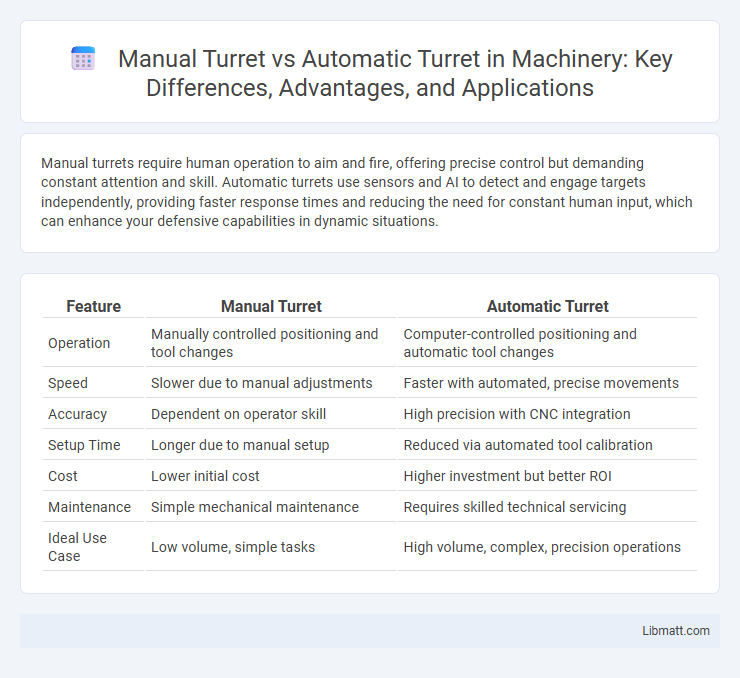Manual turrets require human operation to aim and fire, offering precise control but demanding constant attention and skill. Automatic turrets use sensors and AI to detect and engage targets independently, providing faster response times and reducing the need for constant human input, which can enhance your defensive capabilities in dynamic situations.
Table of Comparison
| Feature | Manual Turret | Automatic Turret |
|---|---|---|
| Operation | Manually controlled positioning and tool changes | Computer-controlled positioning and automatic tool changes |
| Speed | Slower due to manual adjustments | Faster with automated, precise movements |
| Accuracy | Dependent on operator skill | High precision with CNC integration |
| Setup Time | Longer due to manual setup | Reduced via automated tool calibration |
| Cost | Lower initial cost | Higher investment but better ROI |
| Maintenance | Simple mechanical maintenance | Requires skilled technical servicing |
| Ideal Use Case | Low volume, simple tasks | High volume, complex, precision operations |
Introduction to Turret Systems
Manual turret systems require operator control for aiming and firing, relying on human precision and response time. Automatic turret systems incorporate advanced sensors and computerized targeting algorithms to detect, track, and engage threats independently, enhancing accuracy and reaction speed. Your choice between manual and automatic turrets depends on operational needs, desired control level, and technological integration.
Defining Manual Turrets
Manual turrets require direct human operation to control targeting and firing mechanisms, offering precise adjustments but demanding constant attention. These turrets are typically favored in scenarios where operator judgment and flexibility are essential, allowing you to adapt quickly to dynamic combat environments. Unlike automatic turrets, manual versions depend on the operator's skill for accuracy and situational awareness, without relying on advanced sensors or AI systems.
Understanding Automatic Turrets
Automatic turrets operate using advanced sensors and targeting systems that detect and engage targets autonomously, providing faster response times compared to manual turrets. These systems reduce the need for direct human intervention, increasing your operational efficiency and safety in high-risk environments. Understanding automatic turrets involves recognizing their integration of AI and real-time data processing to accurately track and neutralize threats without manual input.
Historical Development of Turret Technology
Manual turrets, first developed in the early 20th century, relied on human operation for targeting and firing, commonly seen in World War I and II armored vehicles and battleships. Automatic turrets emerged mid-20th century, integrating mechanical and later electronic systems to improve firing accuracy and response time, dramatically changing military tactics and vehicle design. Your choice between manual and automatic turrets depends on the balance of historical authenticity, mechanical simplicity, and technological advancement desired in military applications.
Operational Mechanisms: Manual vs Automatic
Manual turrets rely on human operation for aiming and firing, providing direct control but requiring constant attention and skill to maintain accuracy. Automatic turrets use sensors, motors, and computer algorithms to detect targets and execute firing sequences independently, enhancing reaction times and precision without operator input. Your choice between manual and automatic turrets depends on the balance you need between human judgment and automated efficiency in combat scenarios.
Accuracy and Precision Comparison
Manual turrets rely heavily on operator skill, often resulting in varied accuracy and precision due to human error and slower adjustments. Automatic turrets use advanced sensors and computerized targeting systems to consistently achieve higher precision and quicker target acquisition, reducing margin of error. Your effectiveness in combat scenarios significantly improves with automatic turrets, offering reproducible accuracy unattainable by manual operation.
Speed and Responsiveness Differences
Manual turrets rely on human operation, resulting in slower reaction times and limited speed compared to automatic turrets that utilize sensors and motors for rapid target acquisition and tracking. Automatic turrets achieve higher responsiveness with precision aiming and instantaneous adjustments, significantly improving engagement speed in dynamic scenarios. Your choice between manual and automatic turret systems directly impacts operational efficiency, especially when speed and responsiveness are critical for mission success.
Maintenance and Reliability Factors
Manual turrets require regular, hands-on maintenance to ensure mechanical components, such as gears and bearings, remain free of wear and corrosion, impacting overall reliability. Automatic turrets, equipped with electronic and hydraulic systems, demand specialized diagnostic tools and software updates to maintain optimal performance and prevent malfunctions. Your choice between manual and automatic turrets should factor in the availability of skilled technicians and maintenance resources to ensure consistent operational reliability.
Cost and Resource Implications
Manual turrets generally incur lower initial costs compared to automatic turrets due to simpler mechanical components and reduced electronic systems. Automatic turrets require significant investment in sensors, servos, and control software, leading to higher procurement and maintenance expenses. Resource-wise, automatic turrets offer improved operational efficiency by minimizing manpower needs but demand specialized technical support and power consumption.
Future Trends in Turret Technology
Future trends in turret technology emphasize the integration of AI-driven targeting systems and advanced sensors, enhancing precision and response times in both manual and automatic turrets. Automatic turrets increasingly incorporate machine learning algorithms to adapt to dynamic threats, while manual turrets benefit from augmented reality interfaces to assist operators. Your turret system's future readiness depends on adopting these innovations for improved battlefield efficiency and situational awareness.
Manual turret vs automatic turret Infographic

 libmatt.com
libmatt.com